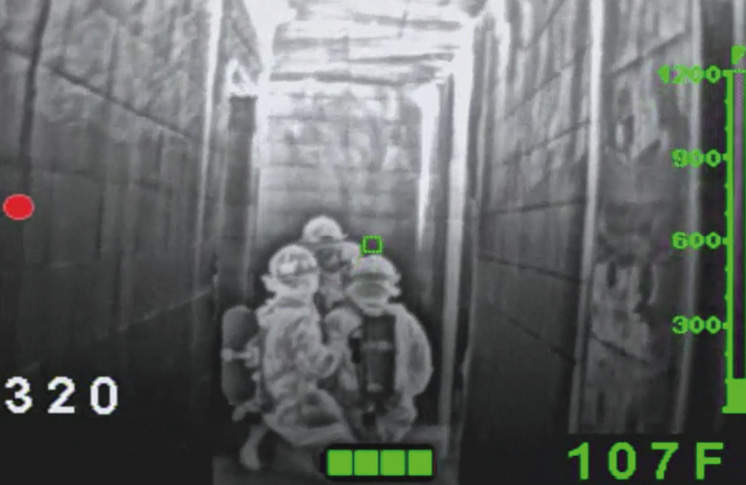
BY MANFRED KIHN

Fire attack is what we do as firefighters. It gets our adrenaline pumping and our passion flowing. We instinctively run into burning buildings risking our lives to save others. That’s our job, and it’s the best job in the world!
We fight fires and bring safety back to chaotic situations. Thank goodness for the brave men and women of the fire service doing what they do every day to keep us safe.
As firefighters, we cannot get too caught up in the adrenaline rush and forget to think strategically and tactfully when using tools to help us navigate through a fire. A thermal imager (TI) can be a firefighter’s best friend when used properly. This tool can help firefighters move more quickly, efficiently, and safely when battling a fire. For this tool to help, it must be used.
Fire departments that have a strategic and tactical TI deployment plan in place will be much more successful using the TI during fire attack. That’s why during fire attack your TI needs to be on the first truck that arrives on the scene. A TI can be extremely useful for showing thermal layers, a safe path for advancement, alternative exits, and the location of the heaviest fire. The TI cannot help in these areas if it arrives on the second or third truck. It must be on scene when the first line is stretched.

1 Firefighters stay below the thermal layering while using a TI to follow the flow path to the seat of the fire. (Photo courtesy of Bullard.)
Best practice is to assign the TI to a specific person (or seat) so that it comes off the engine immediately. Using a truck-mount charging system in the cab to ensure the TI does not get left in a compartment when the crew is stretching its line is another way to keep track of the TI. Do some prework with your TI before you even exit the truck. When arriving on the scene, if possible, roll down your window and start scanning the structure, looking for areas of excessive heat buildup and the effects of natural ventilation.
When scanning a structure using your TI, you need to recognize thermal layers and thermal columns. Seeing the thermal layer can help firefighters predict preflashover conditions. Following the flow of a thermal column back to its origin can lead firefighters directly to the source of the fire. Live fire training is an excellent source for learning how to identify thermal layers and columns. If live fire training is not available, most manufacturers have training videos online that can help you identify these key features using a TI.
Coordinating TI usage with hoseline advancement during fire attack can be your next challenge. One of the simplest drills firefighters can do at the firehouse is practicing hoseline operations while using a TI. Pull the apparatus outside the firehouse and have your crew practice stretching dry attack lines into the apparatus bay. Assign firefighters to specific seats to ensure that each firefighter gets practice leading out the attack line or backing up the line while carrying the TI. Now, have the hose team practice advancing the line and simulating area scans with the TI.
You might be asking yourself which member of the hoseline should be carrying the TI. The preference is for any member except the nozzleman to carry the TI. The nozzleman has enough to do without juggling an additional tool. You can assign the TI to a heelman or the company officer. As the team advances, the firefighter with the TI needs to be vocal by describing the scene to the rest of the crew. Remember, the crew is not seeing what the firefighter using the TI is seeing. By using a TI while advancing the hoseline, the crew can find its way to the seat of the fire more quickly and safely. The TI helps the team see objects that would not otherwise be seen and allows them to navigate faster and with greater ease.
Advancing a hoseline requires teamwork, and if a team member is uncomfortable carrying the TI, he may not perform effectively. It’s important that all members are comfortable carrying and using the TI and can do so while still helping the nozzleman advance into the structure. Practicing hoseline drills may not sound exciting, but when you add in the TI, you now have a more complicated process that presents unique risks. With practice, the team will understand what’s expected from each member.
Other considerations when practicing hoseline advancement include the following: Should the crew bring additional tools along, such as bolt cutters? Can the firefighter with the TI carry extra tools and still advance the line? How are the extra tools carried to ensure that the TI is easily accessible? Do you have to reassign tools to ensure that the special tools, as well as the TI, make it into the structure?
The TI must come off the apparatus first if it’s to help in fire attack. Having your TI as you arrive on scene and as you exit the apparatus can make a huge operational difference and will help increase the safety of the crew. The TI helps the team see objects that would not otherwise be seen and allows them to navigate faster and with greater ease.
Manfred Kihn is a 19-year veteran of the fire service, having served as an ambulance officer, emergency services specialist, firefighter, captain, and fire chief. He has been a member of Bullard’s Emergency Responder team since 2005 and is the company’s fire training specialist for thermal imaging technology. He is certified through the Law Enforcement Thermographers’ Association (LETA) as a thermal imaging instructor and is a recipient of the Ontario Medal for Firefighters Bravery. If you have questions about thermal imaging, you can e-mail him at manfred_kihn@bullard.com.

